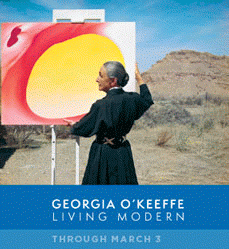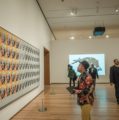
Brings museum’s mission “for the benefit of all the people forever” into the digital age
Cleveland, OH (January 23, 2019)–The Cleveland Museum of Art (CMA) announced today it is using Open Access to make high-resolution digital images and collections data freely available by means of the internet. Open Access means the public now has the ability to share, remix, and reuse images of as many as 30,000 CMA artworks that are in the public domain for commercial as well as scholarly and noncommercial purposes. Additional information on more than 61,000 artworks —both those in the public domain and those with copyright or other restrictions—is also now available.
“The CMA’s Open Access program brings our mission ‘for the benefit of all the people forever’ into the digital age,” said William Griswold, director. “With Open Access, the museum makes its collection of art from all periods and parts of the world easier to access and more relevant to the public. As a global leader among museums, the CMA is committed to transparency and universal access, and we anticipate that other institutions around the world will undertake similar initiatives in order to engage new audiences and help bring art to life for all.”
The CMA’s Open Access program is the most comprehensive to date, with high-resolution images in both JPG and TIF formats as well as a fully operable application programming interface (API) that can be accessed at http://openaccess-api.clevelandart.org/. Among the significant features of the CMA’s Open Access offering are rich metadata with the inclusion of authored text, exhibition history, bibliographic citations, catalogue raisonné numbers, and provenance information for each artwork. Collection data in both the CSV and JSON file formats can be accessed via a GitHub repository at https://github.com/ClevelandMuseumArt/openaccess.
Chief Digital Information Officer Jane Alexander explained, “The Cleveland Museum of Art’s Open Access program builds on its reputation for innovative digital projects including the ARTLENS Gallery. With its world-class collection and talented team, we are able to launch with a robust, usable toolset that will inspire artists, creative developers, and communities to leverage our expansive and comprehensive dataset.”
The CEO of Creative Commons, Ryan Merkley, said, “Creative Commons Search Beta, the open online search and reuse tool that allows high-quality content from the Commons to surface in a seamless and accessible way, now includes as many as 30,000 CMA images under CC0 designation. The goal of Creative Commons is to help institutions and individuals legally share knowledge and creativity to build a more equitable, accessible, and innovative world.”
In conjunction with this new initiative, the museum is launching its newly redesigned online collection to make it easy for individuals, scholars, students, and virtual visitors to have access to a wealth of information on art. This includes up to 35 fields of metadata with descriptive text, creating more possibilities for semantic relationships, contextual interpretations, and translations related to artworks in the collection. In addition, the museum’s website will allow visitors to choose the view that is best for them, whether it’s text-heavy or image-focused. The CMA has also added a refined advanced search to make finding artworks simple and intuitive. This improved feature is powered by Microsoft’s Azure search-as-a-service cloud solution and will enable users to search by specific fields, providing art historians and enthusiasts alike an opportunity to dive deeper into the collection. A newly incorporated elastic search improves the accuracy of results, including the ability to sort more easily. An auto-complete search bar proposes potential searches and suggests correct spellings for artist names.
Kate D’Orazio, Product Marketing Manager at AI Platform, Microsoft, said, “One of our core values at Microsoft is to make the world more accessible, which is why we wanted to make it possible for more people to see and explore art. We are excited to be part of this milestone for public access to the art and humanities. Thanks to the new AI capabilities within Azure Search, the public can explore and understand the CMA’s outstanding collection better than ever before.”
In addition to Creative Commons, Wikimedia, Internet Archive, Artstor, and Artsy have incorporated the CMA’s public domain collection into their websites, thus increasing the view of CMA images around the world and in multiple languages. Because of the museum’s application programming interface (API), these sites will update regularly with new content from the CMA.
Along with its new Open Access digital policy, the CMA allows the visiting public to capture its own still and moving images of the museum’s artworks that are in the public domain and on public display with handheld devices for commercial and noncommercial purposes, provided there is no disruption to museum operations or guest accessibility. The CMA waives rights to media created by users capturing public-domain artworks in its collections and even encourages the public to consider contributing the works they create from its collections with Creative Commons legal tools to the Commons of shared cultural heritage. This policy update is in coordination with the CMA’s own contribution of images and data to the public domain with its Open Access initiative policy: http://www.clevelandart.org/visit/visitor-information/museum-policies.
Visit the CMA’s collection online to research, study, and download Open Access images: http://www.clevelandart.org/art/collection/search.
The CMA acknowledges the Metropolitan Museum of Art (United States), Walters Art Museum (United States), the Rijksmuseum (The Netherlands), Cooper-Hewitt, Smithsonian Design Museum (United States), the Statens Museum for Kunst (Denmark), and the Art Institute of Chicago (United States) for their foundational work with Open Access and use of Creative Commons Zero to share public-domain images and data with the public.
At launch, leading national and international organizations will provide demonstrable examples of the benefits of Open Access, magnifying the initiative’s impact and reach beyond the CMA’s own website and subdomains. Content partners for the launch are American Greetings, Artstor, Artsy, Case Western Reserve University, Creative Commons, Europeana, Hyland Software, Internet Archive, Microsoft Corporation, Pandata, and Wikimedia.
The event and initiative are sponsored by MCPc, BlueBridge Networks, and Kevin and Tracy Goodman. Neal Stimler, senior advisor at Balboa Park Online Collaborative, supported the CMA with its Open Access initiative as a consultant.
Refer to the museum’s Open Access page, clevelandart.org/open-access, for details about the initiative and partnership activities.













